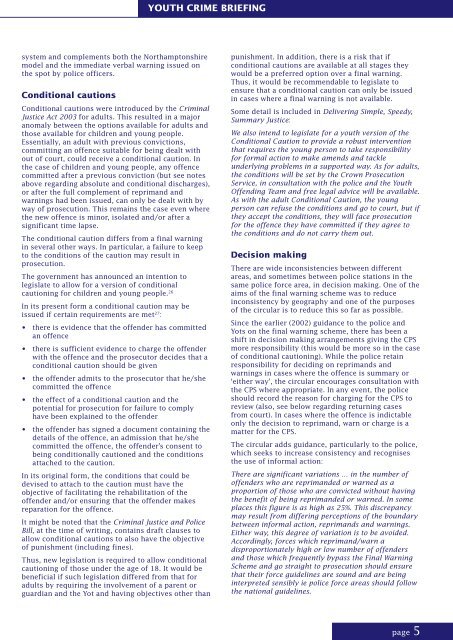Youth Crime briefing - Nacro
Youth Crime briefing - Nacro
Youth Crime briefing - Nacro
Create successful ePaper yourself
Turn your PDF publications into a flip-book with our unique Google optimized e-Paper software.
YOUTH CRIME BRIEFINGsystem and complements both the Northamptonshiremodel and the immediate verbal warning issued onthe spot by police officers.Conditional cautionsConditional cautions were introduced by the CriminalJustice Act 2003 for adults. This resulted in a majoranomaly between the options available for adults andthose available for children and young people.Essentially, an adult with previous convictions,committing an offence suitable for being dealt without of court, could receive a conditional caution. Inthe case of children and young people, any offencecommitted after a previous conviction (but see notesabove regarding absolute and conditional discharges),or after the full complement of reprimand andwarnings had been issued, can only be dealt with byway of prosecution. This remains the case even wherethe new offence is minor, isolated and/or after asignificant time lapse.The conditional caution differs from a final warningin several other ways. In particular, a failure to keepto the conditions of the caution may result inprosecution.The government has announced an intention tolegislate to allow for a version of conditionalcautioning for children and young people. 26In its present form a conditional caution may beissued if certain requirements are met 27 :• there is evidence that the offender has committedan offence• there is sufficient evidence to charge the offenderwith the offence and the prosecutor decides that aconditional caution should be given• the offender admits to the prosecutor that he/shecommitted the offence• the effect of a conditional caution and thepotential for prosecution for failure to complyhave been explained to the offender• the offender has signed a document containing thedetails of the offence, an admission that he/shecommitted the offence, the offender’s consent tobeing conditionally cautioned and the conditionsattached to the caution.In its original form, the conditions that could bedevised to attach to the caution must have theobjective of facilitating the rehabilitation of theoffender and/or ensuring that the offender makesreparation for the offence.It might be noted that the Criminal Justice and PoliceBill, at the time of writing, contains draft clauses toallow conditional cautions to also have the objectiveof punishment (including fines).Thus, new legislation is required to allow conditionalcautioning of those under the age of 18. It would bebeneficial if such legislation differed from that foradults by requiring the involvement of a parent orguardian and the Yot and having objectives other thanpunishment. In addition, there is a risk that ifconditional cautions are available at all stages theywould be a preferred option over a final warning.Thus, it would be recommendable to legislate toensure that a conditional caution can only be issuedin cases where a final warning is not available.Some detail is included in Delivering Simple, Speedy,Summary Justice:We also intend to legislate for a youth version of theConditional Caution to provide a robust interventionthat requires the young person to take responsibilityfor formal action to make amends and tackleunderlying problems in a supported way. As for adults,the conditions will be set by the Crown ProsecutionService, in consultation with the police and the <strong>Youth</strong>Offending Team and free legal advice will be available.As with the adult Conditional Caution, the youngperson can refuse the conditions and go to court, but ifthey accept the conditions, they will face prosecutionfor the offence they have committed if they agree tothe conditions and do not carry them out.Decision makingThere are wide inconsistencies between differentareas, and sometimes between police stations in thesame police force area, in decision making. One of theaims of the final warning scheme was to reduceinconsistency by geography and one of the purposesof the circular is to reduce this so far as possible.Since the earlier (2002) guidance to the police andYots on the final warning scheme, there has been ashift in decision making arrangements giving the CPSmore responsibility (this would be more so in the caseof conditional cautioning). While the police retainresponsibility for deciding on reprimands andwarnings in cases where the offence is summary or‘either way’, the circular encourages consultation withthe CPS where appropriate. In any event, the policeshould record the reason for charging for the CPS toreview (also, see below regarding returning casesfrom court). In cases where the offence is indictableonly the decision to reprimand, warn or charge is amatter for the CPS.The circular adds guidance, particularly to the police,which seeks to increase consistency and recognisesthe use of informal action:There are significant variations … in the number ofoffenders who are reprimanded or warned as aproportion of those who are convicted without havingthe benefit of being reprimanded or warned. In someplaces this figure is as high as 25%. This discrepancymay result from differing perceptions of the boundarybetween informal action, reprimands and warnings.Either way, this degree of variation is to be avoided.Accordingly, forces which reprimand/warn adisproportionately high or low number of offendersand those which frequently bypass the Final WarningScheme and go straight to prosecution should ensurethat their force guidelines are sound and are beinginterpreted sensibly ie police force areas should followthe national guidelines.page
















